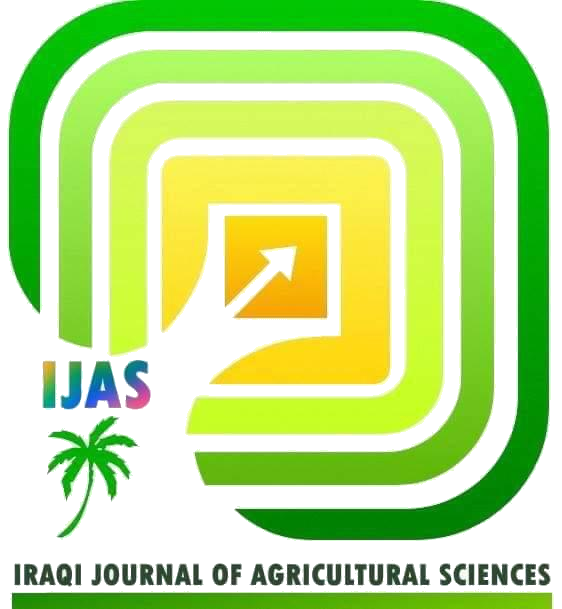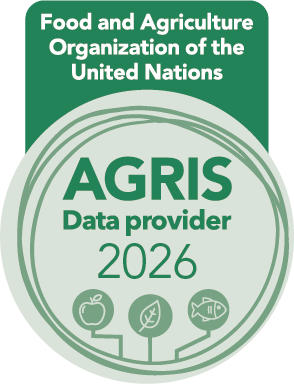EFFECT OF WATER REGIMES AND ORGANIC ACIDS ON Mg- INTERLAYERING FORMATION IN EXPANSIBLE 2:1 MINERALS IN SOME SOILS OF KURDISTAN REGION, IRAQ
DOI:
https://doi.org/10.36103/wsjgs937Keywords:
wet-dry cycles , interstratified minerals, hydroxyl interlayer .Abstract
This study was aimed to investigate the occurrence of chloritization phenomenon in these soils. Three of these pedons were chosen in soil sites differing in their agricultural exploitation, which included: one pedon in an uncultivated soil at Daratw . While the second pedon was dug in soil exploited by the cultivation of wheat at Bardarash . The third pedon was chosen as representative of a forest soil at Tawska Valley. Also, another two soil pedons were exposed to successive cycles of wet and dry, were chosen in Aski Kalak , and Altun Kupri districts. All studied soils were examined by X-ray diffractions. Results showed the presence of Mica, Smectite, Real chlorite and Kaolinite minerals in clay fraction of these soils. Results also, showed the precipitation of Brucite layer into Montmorillonite interlayers and caused to shifting Montmorillonite towards Chlorite mineral in Aski Kalak , Altun Kupri, and forest soil pedons, this was attributed to creation a suitable conditions to encouraged a chloritization phenomenon to occur in these soils.
References
1. Abdulridha, A.N., and S.K. Essa. 2023. Use of Organic matter and sand in improving properties of some soils of holy karbala governorate affected by phenomenon of cracking. Iraqi Journal of Agricultural Sciences 54(1): 268-281. https://doi.org/10.36103/ijas.v54i1.1699
2. Anna, G., J., Dietel, R., Dohrmann, and T. Rennert, 2020. What are the nature and formation conditions of hydroxy‐interlayered minerals (HIMs) in soil?. Journal of Plant Nutrition and Soil Science, 183(1), 12-26. https://doi.org/10.1002/jpln.201900283
3. AL-Shammare, A.H., and S.K. Essa. 2020. Study of the contribution of clay, silt, organic matter, free iron oxides, and calcium carbonate in CEC to some of wasit and maysan soils. Indian J. Ecology 47(9): 45-56.
4. Alexandre, V., D., Lemarchand, C., Collignon, M., Granet, F., Chabaux, and M. P. Turpault, 2013. Experimental dissolution vs. transformation of micas under acidic soil conditions: clues from boron isotopes. Geochimica et Cosmochimica Acta, 117, 144-160. https://doi.org/10.1016/j.gca.2013.04.012
5. Bonifacio, E., G., Falsone, G., Simonov, T., Sokolova, and I. Tolpeshta, 2009. Pedogenic processes and clay transformations in bisequal soils of the Southern Taiga zone. Geoderma, 149(1-2), 66-75. https://doi.org/10.1016/j.geoderma.2008.11.022
6. Baglieri, A., A. Loppolo., M. Negre., and M. Gennari. 2007. A Method for Isolating Soil Organic Matter After the Extraction of Humic and Fulvic Acids. Organic Geochemistry. Vol. 38, Issue 1: 140-150.
7. Chavez-Garcia, M.L, L. Pablo-Galan., and M. Saucedo-Ramirez. 2006. Synthesis of Intercalated Al-hydroxy-montmorillonite. J. Mex. Chem. Soc. 50(1): 36 – 41.
8. Corey, L, J., Harden, and K. Maher, 2014. Modeling the influence of organic acids on soil weathering. Geochimica et Cosmochimica Acta, 139, 487-507. https://doi.org/10.1016/j.gca.2014.05.003
9. Dahlgren, R. A., J. P., Dragoo, and F. C. Ugolini, 1997. Weathering of Mt. St. Helens tephra under a cryic‐udic climatic regime. Soil Science Society of America Journal, 61(5), 1519-1525. https://doi.org/10.2136/sssaj1997.03615995006100050032x
10. Egli, M., C., Merkli, G., Sartori, A., Mirabella, and M. Plötze, 2008. Weathering, mineralogical evolution and soil organic matter along a Holocene soil toposequence developed on carbonate-rich materials. Geomorphology, 97(3-4), 675-696. https://doi.org/10.1016/j.geomorph.2007.09.011
11. Gao, J., R., Mikutta, B., Jansen, G., Guggenberger, C., Vogel, and K. Kalbitz, 2020. The multilayer model of soil mineral–organic interfaces—a review. Journal of Plant Nutrition and Soil Science, 183(1), 27-41. https://doi.org/10.1002/jpln.201900530
12. Inda, A. V., J., Torrent, V., Barrón, and C. Bayer, 2010. Aluminum hydroxy-interlayered minerals and chemical properties of a subtropical Brazilian Oxisol under no-tillage and conventional tillage. Revista Brasileira de Ciência do Solo, 34, 33-41. https://doi.org/10.1590/S0100-06832010000100004
13. He, H.E., S.H. Yehong., and L. I. Chunye. 2008. Characterization of humic acids extracted from the sediments of the various rivers and Lakes in China. J. Environ. Sci. 20: 1294-1299.
14. Jin Li, J., H. Bing Ji., W. Wang., F. Dong., C. Yin., Li. Zhang., R. Li., and J. Gao. 2022. Study on The Profile Distribution and Morphology of Soil Humic Substances in Karst Area of Zunyi City, China. Sustainability 2022, 14 (10), 6145, https://doi.org 110.3390/ su14106145.
15. Lagaly, G., M. Ogawa., and I. Dekany. 2006. Chapter 7.3 Clay Mineral Organic Interactions. Developments in Clay Science. Vol. 1: 309-377.
16. McGarry, S. F., and A. Baker, 2000. Organic acid fluorescence: applications to speleothem palaeoenvironmental reconstruction. Quaternary Science Reviews, 19(11), 1087-1101. https://doi.org/10.1016/S0277-3791(99)00087-6
17. Meunier, A. 2007. Soil Hydroxy-Interlayered Minerals: a Re-interpretation of Their Crystallochemical Properties. Clay. Clay Miner. 55: 380– 388.
18. Najafi-Ghiri, M., M., Niazi, M., Khodabakhshi, H. R., Boostani, and H. R. Owliaie, 2019. Mechanisms of potassium release from calcareous soils to different salt, organic acid and inorganic acid solutions. Soil Research, 57(3), 301-309. https://doi.org/10.1071/SR18301
19. Ruiz-Hitzky, E., and A. Van Meerbeek. 2006. Chapter 10.3 Clay Mineral- and Organoclay- Polymer Nanocomposite. Developments in Clay Science. Vol. 1: 583-621.
20. Ryan J., G. Estefan., and A. Rashid. 2001. Soil and Plant Analysis Laboratory Manual. 2nd Edition. International Center for Agriculture Research in The Dry Areas (ICARDA).
21. Sokolova, T. A. 2020. Low-molecular-weight organic acids in soils: sources, composition, concentrations, and functions: a review. Eurasian Soil Science, 53, 580-594. https://doi.org/10.1134/S1064229320050154
22. Sparks, D.L., A.L. Page., P.A. Helmke., and R.H. Loeppert. 2020. Methods of Soil Analysis, Part 3: Chemical Methods. Book. Soil Sci. Soc. of Am. Inc. 677 South Segoe Road, Madison, W1 53711-1086 USA: 49-65.
23. Sokolova, T. A., I.I.Tolpeshta., and I.V. Topunova. 2010. Biotite weathering in podzolic soil under conditions of a model field experiment. Eurasian Soil Sci. 43: 1150– 1158.
24. Stroble, B.W., H.C. Hansen., O.K. Borggaard., M.K. Andersen., and K.R. Rasmussen. 2000. Composition and Reactivity of DOC in Forest Floor Soil Solution in Relation to Tree Species and Soil Type. Biogeochemistry, in Press.
25. Szymański, W., M. Skiba., and A. Błachowski. 2017. Influence of Redox Processes on clay mineral transformation in retisols in the carpathian foothills in poland. is a ferrolysis process present? J. Soil. Sediment. 17: 453– 470.
26. Yariv, S., and I. Lapides. 2005. The use of thermo-xrd- analysis in the study of organo-smectite complexes robert mackenzie memorial lecture. J. of Thermal Analysis and Calorimetry. Vol. 80, Issue 1: 11-26.
27. Zanelli, R., M. Egli., A. Mirabella., D. Giaccai., and M. Abdelmould . 2007. Vegetation Effects on Pedogenetic Forms of Fe, Al and Si on Clay Minerals in Soils in Southern Switzerland and Northern Italy. Geoderma 141: 119-129.
Downloads
Published
Issue
Section
License
Copyright (c) 2025 IRAQI JOURNAL OF AGRICULTURAL SCIENCES

This work is licensed under a Creative Commons Attribution-NonCommercial 4.0 International License.

2.jpg)


